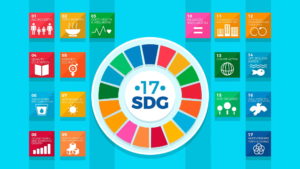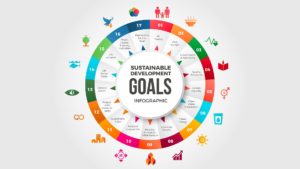The Sustainable Development Goals (SDGs) are simply a global to-do list. The United Nations created these intending to improve the world by 2030. The urgent global issues that need coordinated action gave rise to the Sustainable Development Goals (SDGs).
The world was not feeling well for several reasons, therefore, the giant body made this list to make the world a better place. Furthermore, it is understandable that conventional approaches or global solutions to development were insufficient when billions of people continued to live in poverty and experience inequality.
At the same time, serious risks to the sustainability of the world came from environmental dreadful conditions, including loss of biodiversity and climate change. Advancement was in a weak position because of long-term social problems including prejudice and gender inequality.
In light of this, the SDGs were developed in 2015 as a global call to action to address unified concerns in their entirety. Besides addressing poverty, hunger, health, education, gender equality, clean water, sustainable cities, climate action, and other issues, they offered a framework with Sustainability goal 17.
To cut a long story short, they were established to tackle global issues and establish goals for enhancing human well-being and environmental preservation by 2030.
If we look at the back story, the plan aimed to progress the Millennium Development Goals (MDGs), a set of objectives that were recognized in 2000 and had a deadline of 2015. The sustainable goals of the United Nations were built upon the MDGs By addressing a wider range of topics and aiming for a more inclusive and sustainable approach to development.
Furthermore, a process of consultation and negotiation including governments, international organizations, civil society organizations, and other global players resulted in the development of the SDGs. They are meant to be universal, which means that all nations, regardless of their degree of development, should strive to fulfill them.
We live on a planet and whatever bad will happen, everyone will suffer no matter what. Even though it was long before recognized, with every day passing, the urgency is increasing. Currently, there is economic and political instability in several nations, conflicts, poverty, water and food crisis, and on the top the climate and environment are turning towards serious crisis.
Be it the use of sustainable materials, or genuine global solutions, the world needs to be united to work hard on the serious issue of sustainability.
A Guide To 17 Sustainable Goals Of The United Nations (SDGS)

Let us all understand these important aims. Being an inhabitant of this world, everyone should know the goals of sustainability and should be aware of what world leaders are doing.
In total, there are 17 goals, covering a wide range of fundamental issues such as ensuring that everyone has access to enough food, ensuring that everyone can attend school, and ensuring that we take care of the environment.
All of these objectives are connected. Therefore, achieving one aim can help in achieving another. For instance, ensuring that more people have access to clean water contributes to better health, which is another goal.
The foundation is that nations are cooperating to advance, particularly for those who are most in need. This means everyone must contribute and do their share including corporations, governments, and common citizens.
The Sustainable Development Goals (SDGs) are essentially a road plan for utilizing global cooperation and global solutions and resources to make the world a safer, healthier, and more equitable place for everyone.
Nonetheless, to begin with the first point,
- No Poverty: Put an end to poverty everywhere it exists.
- Zero Hunger: It aims to eradicate hunger, increase nutrition and food security, and advance sustainable agriculture.
- Maintaining good health and well-being: It means encouraging well-being in people of all ages.
- High-quality education: It should be provided inclusively and equitably, encouraging possibilities for lifelong learning for all.
- Gender Equality: Make all women and girls stronger and work toward gender equality.
- Clean Water and Sanitation: Make sure that everyone has access to clean water and sustainable sanitation management.
- Economical and Clean Energy: Make sure that everyone has access to modern, cheap, dependable, and sustainable energy.
- Decent work and economic growth: Encourage full and productive employment, consistent, inclusive, and sustainable economic growth, as well as decent work for everybody.
- Infrastructure, Industry, and Innovation: Develop innovative ideas, encourage inclusive and sustainable industry, and construct robust infrastructure.
- Decreased Inequality: Decrease inequality both within and between nations.
- Sustainable cities and communities: The goal is to create inclusive, safe, resilient, and sustainable cities and human settlements.
- Responsible consumption and production: Sustainable patterns of consumption and production are important for responsible consumption and production.
- Climate Action: Act quickly to lessen the effects of climate change.
- Life beneath the water: Preserve and responsibly utilize the oceans, seas, and marine resources to promote sustainable growth.
- Life on Land: Preserve, repair, and encourage the sustainable use of terrestrial ecosystems; manage forests responsibly; oppose desertification; stop and reverse land degradation; and stop biodiversity loss.
- Peace, Justice, and Strong Institutions: Nurture inclusive and peaceful societies for long-term growth; guarantee everyone’s access to justice; and create inclusive, accountable, and strong institutions at all levels.
- Partnerships for the Goals: Refresh the global partnership for sustainable development and strengthen the means of implementation.
What Future Holds For Sustainable Development Goals?

The future holds sustainability for all and this is what SDGs want. The commitment of the international community to sustainable development will determine the future of the Sustainable Development Goals (SDGs).
There will be a greater focus on cooperation between governments, corporations, civil society, and international organizations to address issues including poverty, inequality, climate change, and environmental degradation.
The need for integrated ways to achieve the SDGs and their interdependence will probably be recognized more and more. Progress toward the goals will be accelerated by innovations in technology, finance, and governance, but overcoming roadblocks like political inertia, a lack of resources, and geopolitical tensions will still be difficult.
The SDGs’ achievement will depend on persistent political will, resource mobilization, and coordinated national and international action.
Nonetheless. what role are you playing with SDGs to make the world sustainable and happier?













